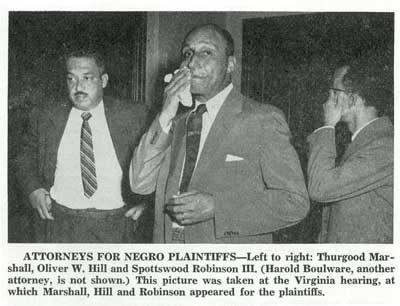
What Was Brown V. Board of Education?
The Prince Edward Case
and the Brown Decision
The State Responds:
Massive Resistance
Virginians Respond: Library of Virginia Documents
Additional Resources:
Brown v. Board of Education:
Selected Published Materials
at the Library of Virginia (pdf)
Brown v. Board of Education was a group of five legal appeals that challenged the "separate but equal" basis for racial segregation in public schools in Kansas, Virginia (Dorothy Davis v. County School Board of Prince Edward), Delaware, South Carolina, and the District of Columbia. The appeals reached the Supreme Court about the same time, and because they all dealt with the same issues, the Court heard arguments on them together. Because the Kansas case arrived first, the combined appeal was known as Brown et al v. Board of Education of Topeka, Shawnee County, Kansas, et al. In each case, the legal office of the National Association for the Advancement of Colored People (NAACP) represented the plaintiffs, and NAACP lawyers, such as Spottswood Robinson, Oliver Hill, and Thurgood Marshall, argued that the black students' rights had been violated under the Equal Protection Clause of the Fourteenth Amendment. In all five cases, inequality in curriculum, school structures, and transportation were the key issues.

"Attorneys for Negro Plaintiffs" (Thurgood Marshall, Oliver Hill, and Spottswood W. Robinson III). Published in Southern School News 2, no. 2 (August 1955):7.
In 1951 Oliver Brown and twelve other parents, supported by the local chapter of the NAACP, filed suit against the Topeka, Kansas, Board of Education, after the board refused to allow their children attend the white school located in their neighborhoods. To reach their schools, the children rode buses to schools located several miles from their homes. Arguing that African American children attending a segregated school were made to feel interior to whites, Dr. Hugh W. Speer testified that
if the colored children are denied the experience in school of associating with white children, who represent 90 percent of our national society in which these colored children must live, then the colored child’s curriculum is being greatly curtailed. The Topeka curriculum or any school curriculum cannot be equal under segregation.
Attorneys for the Board of Education argued that attending segregated schools prepared children for the segregated society they would face as adults and offered key figures such as Frederick Douglass, Booker T. Washington, and George Washington Carver as examples of individuals who overcame racial barriers to achieve fame. Although agreeing with the plaintiff’s argument that segregation had a damaging effect on black schoolchildren, the justices relied on the legal precedent of Plessyto rule in favor of the Board of Education. Brown appealed to the U.S. Supreme Court on October 1, 1951.
In South Carolina, Harry Briggs and nineteen other parents filed suit against R. W. Elliot, president of the Clarendon County school board. Clarendon County provided bus transportation for white children but not for black students. The plaintiffs requested that the county provide buses for their children, but the petition was ignored. With Thurgood Marshall and Harold Boulware serving as counsel, Briggs v. Clarendon County went before the U.S. District Court for the District of South Carolina in May 1951. The justices ruled 2–1 against the parents but ordered the school board to equalize schools.
Two cases—Belton v. Gebhart and Bulah v. Gebhart—involved bus transportation and inferior school structures. In Belton v. Gebhart, black parents in Claymont petitioned for both a better school building and bus transportation. Sarah Bulah (Bulah v. Gebhart) asked for bus transportation for black children in Hockessin. Parents of eleven children joined Sarah Bulah’s suit. Argued before the Delaware Court of Chancery which found for the parents, the cases were combined and appealed to the U.S. Supreme Court by the Delaware Board of Education.
Attempting to end segregated schools in the District of Columbia, Gardner Bishop and the Consolidated Parents Group, Inc., tried to enroll eleven African American students in the newly-completed John Philip Sousa Junior High School. The students were denied entrance. James Nabrit Jr., of Howard University, argued in the case Bolling v. Sharpe, that segregation itself was unconstitutional. The U. S. District Court dismissed the case, based on a Court of Appeals ruling in Carr v. Corning that segregated schools were constitutional. The U. S. Supreme Court included Nabrit’s appeal as part of Brown. Because the Fourteenth Amendment was not applicable to the District of Columbia, the Supreme Court gave a separate opinion on Bolling v. Sharpe, basing its decision on the equal protection clause of the Fifth Amendment.

